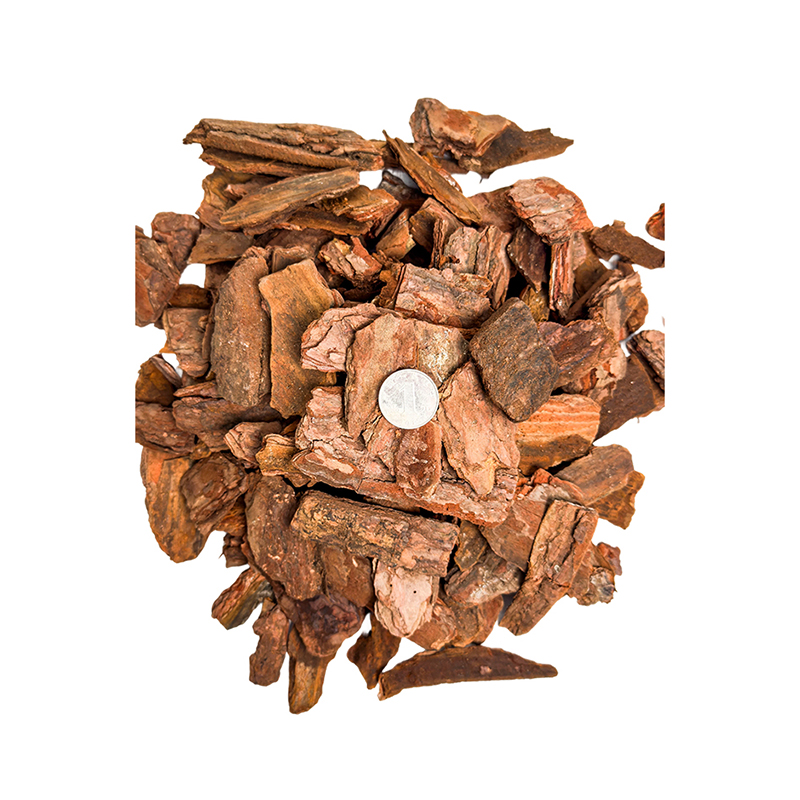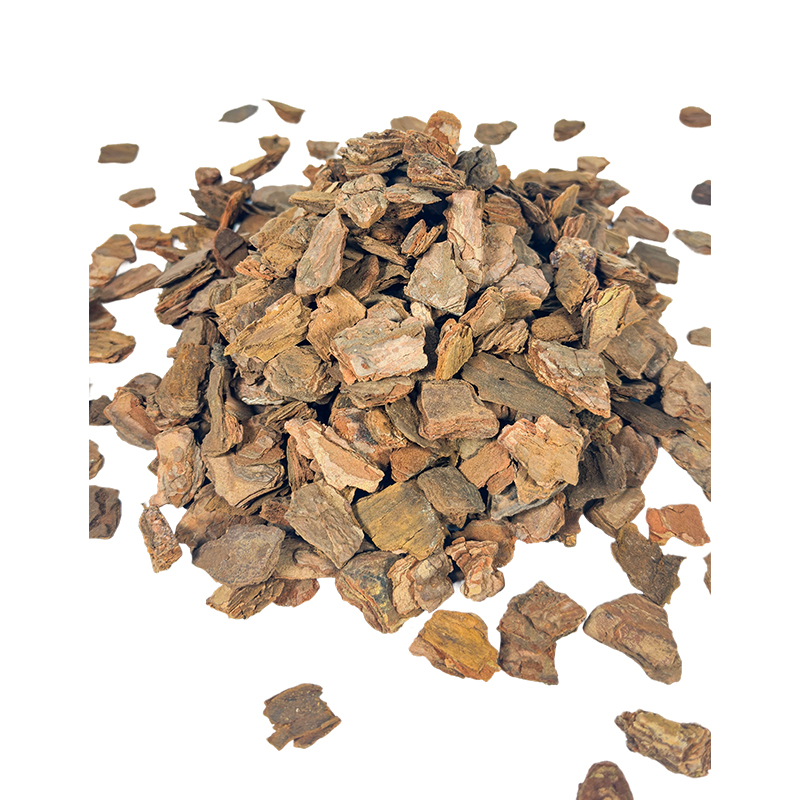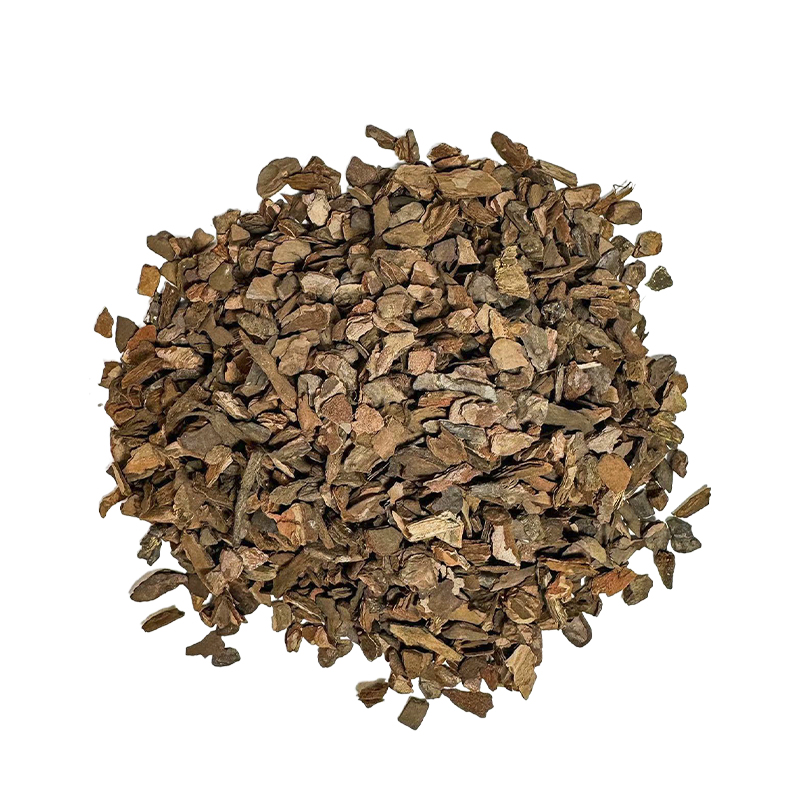How do the natural deodorizing bacteria in pine bark continuously decompose odor molecules in the biofilters of sewage treatment plants and maintain long-lasting deodorizing effects?
Release Time : 2025-08-05
At the intersection of modern ecological governance and landscape design, pine bark, a gift from nature, is quietly reshaping our understanding of environmental beautification and ecological restoration with its unique and diverse value. No longer simply a bygone forest relic, it is a carefully selected and processed organic landscape mulch, available wholesale in sewage treatment plants, gardens, and urban landscapes, becoming a green link between natural cycles and the built environment. Its large, uniform shape, average thickness of approximately 1 cm, and fresh texture that retains its original color not only demonstrate the material's high quality but also indicate its long-lasting and stable performance in a variety of applications.
The superiority of pine bark stems primarily from its complete preservation and scientific activation of its natural properties. Each piece of pine bark is sourced from sustainably managed forests and rigorously screened to ensure uniform size and a durable texture. Its undyed, natural color, a calming earthy brown, blends seamlessly with the natural environment, avoiding the potential ecological risks of artificial coloring. More importantly, the product retains a natural deodorizing bacterial community. These microorganisms are not added later, but rather a long-standing, active community symbiotically present within the bark tissue. When pine bark is laid in a specific environment, these microorganisms naturally activate and continuously decompose organic pollutants and odor molecules. In particular, in the biological deodorization systems of sewage treatment plants, they serve as a highly efficient and cost-effective "biological filter media," addressing industrial challenges in an ecologically sound manner and transforming waste into a functional material.
The core value of pine bark lies in its synergistic release of multiple ecological benefits. As an organic mulch in landscaping, pine bark spreads on the soil surface, forming a breathable, water-retaining barrier. It effectively slows evaporation, significantly saving water; inhibits nutrient loss from the soil, helping to retain nutrients; and forms an insulating layer in winter, providing warmth and protecting plant roots from frost damage. Its physical covering properties effectively control weeds, reducing herbicide use and the labor costs of manual weeding. Even more remarkable, the natural terpenes released by pine bark repel mosquitoes, creating a more pleasant microclimate for outdoor spaces. This comprehensive benefit of conserving water, conserving fertilizer, retaining heat, preventing weeds, and repelling insects not only enhances the layered and natural beauty of greenery, but also fundamentally reduces both the initial investment and long-term maintenance costs of greening projects, providing a cost-effective and sustainable solution for urban greening.
Pine bark offers a return to the essence of ecological wisdom. Whether for municipal gardening departments, landscape designers, or private garden owners, choosing pine bark represents a low-intervention, high-efficiency ecological strategy. It is easy to install, requiring no complex machinery. Over time, pine bark slowly decomposes, returning organic matter and nutrients to the soil, continuously improving soil quality and creating a virtuous cycle. Its durability ensures a long replacement cycle, reducing resource consumption and environmental footprint. In flower mirror decorations, its natural texture and color perfectly complement the plants, highlighting the vibrant colors of the flowers and creating a landscape that is both wild and refined.
The deeper significance of pine bark lies in its role as a model of circular economy and ecological restoration. Transforming pine bark, a residual product from forestry processing, into a high-value ecological product represents the ultimate utilization of resources. In wastewater treatment, it replaces some chemical deodorants and expensive synthetic fillers, purifying the air through biodegradation, embodying the advanced concept of "restoring nature with the power of nature." In urban spaces, it mitigates the heat island effect, enhances biodiversity, and creates a healthier, more natural living environment for citizens.
Though naturally occurring, pine bark embodies a profound understanding of ecological balance and sustainable development. Its decomposition nourishes new life, its inherent microbial flora purifies the air, and its simple form beautifies the city. In this era of pursuing green, low-carbon and harmonious coexistence, it is becoming the most intelligent "green skin" in ecological engineering in a quiet and irreplaceable way, making every coverage a gentle return to the earth and allowing every green space to breathe the fragrance of nature.
The superiority of pine bark stems primarily from its complete preservation and scientific activation of its natural properties. Each piece of pine bark is sourced from sustainably managed forests and rigorously screened to ensure uniform size and a durable texture. Its undyed, natural color, a calming earthy brown, blends seamlessly with the natural environment, avoiding the potential ecological risks of artificial coloring. More importantly, the product retains a natural deodorizing bacterial community. These microorganisms are not added later, but rather a long-standing, active community symbiotically present within the bark tissue. When pine bark is laid in a specific environment, these microorganisms naturally activate and continuously decompose organic pollutants and odor molecules. In particular, in the biological deodorization systems of sewage treatment plants, they serve as a highly efficient and cost-effective "biological filter media," addressing industrial challenges in an ecologically sound manner and transforming waste into a functional material.
The core value of pine bark lies in its synergistic release of multiple ecological benefits. As an organic mulch in landscaping, pine bark spreads on the soil surface, forming a breathable, water-retaining barrier. It effectively slows evaporation, significantly saving water; inhibits nutrient loss from the soil, helping to retain nutrients; and forms an insulating layer in winter, providing warmth and protecting plant roots from frost damage. Its physical covering properties effectively control weeds, reducing herbicide use and the labor costs of manual weeding. Even more remarkable, the natural terpenes released by pine bark repel mosquitoes, creating a more pleasant microclimate for outdoor spaces. This comprehensive benefit of conserving water, conserving fertilizer, retaining heat, preventing weeds, and repelling insects not only enhances the layered and natural beauty of greenery, but also fundamentally reduces both the initial investment and long-term maintenance costs of greening projects, providing a cost-effective and sustainable solution for urban greening.
Pine bark offers a return to the essence of ecological wisdom. Whether for municipal gardening departments, landscape designers, or private garden owners, choosing pine bark represents a low-intervention, high-efficiency ecological strategy. It is easy to install, requiring no complex machinery. Over time, pine bark slowly decomposes, returning organic matter and nutrients to the soil, continuously improving soil quality and creating a virtuous cycle. Its durability ensures a long replacement cycle, reducing resource consumption and environmental footprint. In flower mirror decorations, its natural texture and color perfectly complement the plants, highlighting the vibrant colors of the flowers and creating a landscape that is both wild and refined.
The deeper significance of pine bark lies in its role as a model of circular economy and ecological restoration. Transforming pine bark, a residual product from forestry processing, into a high-value ecological product represents the ultimate utilization of resources. In wastewater treatment, it replaces some chemical deodorants and expensive synthetic fillers, purifying the air through biodegradation, embodying the advanced concept of "restoring nature with the power of nature." In urban spaces, it mitigates the heat island effect, enhances biodiversity, and creates a healthier, more natural living environment for citizens.
Though naturally occurring, pine bark embodies a profound understanding of ecological balance and sustainable development. Its decomposition nourishes new life, its inherent microbial flora purifies the air, and its simple form beautifies the city. In this era of pursuing green, low-carbon and harmonious coexistence, it is becoming the most intelligent "green skin" in ecological engineering in a quiet and irreplaceable way, making every coverage a gentle return to the earth and allowing every green space to breathe the fragrance of nature.







